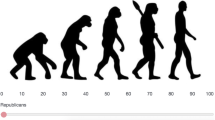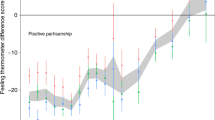Abstract
Recent evidence indicates that partisans discriminate against those from the opposing party. However, it is still unclear whether partisan out-group prejudice reveals a desire for out-group harm or in-group help. We investigate the conditions under which these tendencies arise. Using one observational survey and three survey experiments, we show that when given the chance to either harm the out-group or help the in-group, people tend to choose the latter. Yet while the tendency to help the in-group appears to be primary, we also show that under situations of symbolic threat to partisan identity, respondents shift gears and opt for harming the out-group as a strategy to defend the status of their political group identity. These results add to our understanding of how partisan identity and polarization works in non-elites.



Similar content being viewed by others
Notes
This group of scholars explain polarization at this level as an artifact of extreme political activists that is erroneously discussed by the media as a problem in the electorate.
We note here that since Study 1 is observational, the results from this online convenience sample must be taken with a grain of salt, as the individual survey takes are non-representative of the American population.
Data and coding for all four studies can be found in the Harvard Dataverse at the following address: https://dataverse.harvard.edu/dataset.xhtml?persistentId=doi:10.7910/DVN/J33F9O
Control variables can still reduce noise in experimental contexts (Gerber and Green 2012) and serve as robustness checks.
We note here at that in the normal circumstances of the Control condition, Democrats (M = .39, SE = .05) were more likely to select the out-party harm article than Republicans (M = .181, SE = .06) at z(33,73) = − 2.18, p = .02.
We also ran this model as a logistic regression in which the dependent variable is coded such that 1 = Chose Harm the Out-Party and 0 = Chose Help In-Party or Neither. Results can be seen in Table 9 of the Appendix. In this model, the threat condition produces a null result. We believe this is because harming the out-party is not a unique option from the combination of the other two options; all three are conceptually distinct and should be estimated with the multinomial logistic regression.
Interestingly, our findings are robust against partisanship strength. Greene (1999, 2002) has shown that the social component of partisanship increases for people who identify as Strong Democrats and Strong Republicans. People who fall into these categories should more profoundly internalize the threat. We report the interaction between the experimental condition and partisan strength for each of the three experimental studies in the Online Appendix Tables 2, 3 and 4. Surprisingly, we found no significant effects on the interaction term in any of the studies. This suggests that the threat’s effect on weak party identifiers is just as impactful as it is on strong party identifiers—at least in our samples.
References
Abramowitz, A. I., & Saunders, K. L. (2008). Is polarization a myth? The Journal of Politics, 70(02), 542–555.
Abramowitz, A. I., & Webster, S. (2016). The rise of negative partisanship and the nationalization of US elections in the 21st century. Electoral Studies, 41, 12–22.
Allport, G. (1954). The nature of prejudice. New York: Perseus Books.
Brambilla, M., Rusconi, P., Sacchi, S., & Cherubini, P. (2011). Looking for honesty: The primary role of morality (vs. sociability and competence) in information gathering. European Journal of Social Psychology, 41(2), 135–143.
Brambilla, M., Sacchi, S., Rusconi, P., Cherubini, P., & Yzerbyt, V. Y. (2012). You want to give a good impression? Be honest! Moral traits dominate group impression formation. British Journal of Social Psychology, 51(1), 149–166.
Brewer, M. B. (2007). The importance of being we: Human nature and intergroup relations. American Psychologist, 62(8), 728.
Carver, C. S., & Harmon-Jones, E. (2009). Anger is an approach-related affect: Evidence and implications. Psychological Bulletin, 135(2), 183.
CNN (2017). “Eric Trump: Democrats in Washington are not even people”. Retrieved Feb 19, 2019, from https://www.cnn.com/2017/06/07/politics/eric-trump-hannity-democrats-obstruction/index.html.
Conway, P. (2018). The core of morality is the moral self. In K. Gray, J. Graham, K. Gray, & J. Graham (Eds.), Atlas of moral psychology (pp. 149–164). New York: Guilford Press.
Fiorina, M. P., Abrams, S. J., & Pope, J. C. (2005). Culture war?. Pearson Longman NY: The myth of a polarized America.
Fiorina, M. P., Abrams, S. A., & Pope, J. C. (2008). Polarization in the American public: Misconceptions and misreadings. Journal of Politics, 70(2), 556–560.
Gallup (2013). Gridlock is top reason Americans are critical of congress. Retrieved March 20, 2018, from http://news.gallup.com/poll/163031/gridlock-top-reason-americans-critical-congress.aspx.
Gerber, A. S., & Green, D. P. (2012). Field experiments: Design, analysis, and interpretation. New York, NY: WW Norton.
Graham, J., Haidt, J., & Nosek, B. A. (2009). Liberals and conservatives rely on different sets of moral foundations. Journal of Personality and Social Psychology, 96(5), 1029.
Green, D. P., Palmquist, B., & Schickler, E. (2004). Partisan hearts and minds: Political parties and the social identities of voters. New Haven: Yale University Press.
Greene, S. (1999). Understanding party identification: A social identity approach. Political Psychology, 20(2), 393–403.
Greene, S. (2002). The social-psychological measurement of partisanship. Political Behavior, 24(3), 171–197.
Guess, A., Lyons, B., Nyhan, B., & Reifler, J. (2018). Avoiding the echo chamber about echo chambers: Why selective exposure to like-mined political news is less prevalent than you think. Retrieved March 20, 2018, from Knight Foundation Technical Report: https://kf-site-production.s3.amazonaws.com/media_elements/files/000/000/133/original/Topos_KF_White-Paper_Nyhan_V1.pdf.
Haidt, J. (2012). The righteous mind: Why good people are divided by politics and religion. New York: Vintage.
Huddy, L., Mason, L., & Aarøe, L. (2015). Expressive partisanship: Campaign involvement, political emotion, and partisan identity. American Political Science Review, 109(1), 1–17.
Huffington Post (2017). The deeply immoral values of today’s republican leaders. Retrieved March 20, 2018, from https://www.huffingtonpost.com/entry/the-deeply-immoral-values-of-todays-republican-leaders_us_5a2eb9f7e4b04cb297c2aee5.
Iyengar, S., & Krupenkin, M. (2018). The strengthening of partisan affect. Political Psychology, 39, 201–218.
Iyengar, S., Sood, G., & Lelkes, Y. (2012). Affect, not ideology: A social identity perspective on polarization. Public Opinion Quarterly, 76(3), 405–431.
Iyengar, S., & Westwood, S. J. (2015). Fear and loathing across party lines: New evidence on group polarization. American Journal of Political Science, 59(3), 690–707.
Layman, G. C. (1999). “Culture Wars” in the American party system religious and cultural change among partisan activists since 1972. American Politics Quarterly, 27(1), 89–121.
Layman, G. C., Carsey, T. M., & Horowitz, J. M. (2006). Party polarization in American politics: Characteristics, causes, and consequences. Annual Review of Political Science, 9, 83–110.
Leach, C. W., Ellemers, N., & Barreto, M. (2007). Group virtue: The importance of morality (vs. competence and sociability) in the positive evaluation of in-groups. Journal of Personality and Social Psychology, 93(2), 234.
Lelkes, Y., & Westwood, S. J. (2017). The limits of partisan prejudice. The Journal of Politics, 79(2), 485–501.
McCarty, N., Poole, K., & Rosenthal, H. (2006). Polarized America: The dance of ideology and unequal riches. Cambridge, MA: MIT Press.
New York Times (2015). Americans view on money in politics. Retrieved June 2, 2015, from http://www.people-press.org/2015/11/23/6-perceptions-of-elected-officials-and-the-role-of-money-in-politics/.
Petrocik, J. R. (2009). Measuring party support: Leaners are not independents. Electoral Studies, 28(4), 562–572.
Pew (2015). Beyond distrust: How Americans view their government. Retrieved Nov 23, 2015, from http://www.people-press.org/2015/11/23/6-perceptions-of-elected-officials-and-the-role-of-money-in-politics/.
Riek, B. M., Mania, E. W., & Gaertner, S. L. (2006). Intergroup threat and outgroup attitudes: A meta-analytic review. Personality and Social Psychology Review, 10, 336–353.
Stonecash, J. M., Brewer, M. D., & Mariani, M. D. (2003). Diverging parties: Social change, realignment, and party polarization. Boulder: Westview Press.
Strohminger, N., & Nichols, S. (2014). The essential moral self. Cognition, 131(1), 159–171.
Stroud, N. J. (2008). Media use and political predispositions: Revisiting the concept of selective exposure. Political Behavior, 30(3), 341–366.
Tajfel, H. (1981). Human groups and social categories. Cambridge: Cambridge University Press.
Tajfel, H., & Turner, J. C. (1979). An integrative theory of intergroup conflict. The Social Psychology of Intergroup Relations, 33(47), 74.
Täuber, S., & Zomeren, M. (2013). Outrage towards whom? Threats to moral group status impede striving to improve via out-group-directed outrage. European Journal of Social Psychology, 43(2), 149–159.
Tetlock, P. E. (2003). Thinking the unthinkable: Sacred values and taboo cognitions. Trends in Cognitive Sciences, 7(7), 320–324.
Tetlock, P. E., Kirstel, O. V., Elson, S. B., Green, M. C., & Lerner, J. S. (2000). The psychology of the unthinkable: Taboo trade-offs, forbidden base rates, and heretical counterfactuals. Journal of Personality and Social Psychology, 78(5), 853–870.
The Guardian (2018). The moral and intellectual bankruptcy of the republican party. Retrieved March 20, 2018, from https://www.theguardian.com/environment/climate-consensus-97-per-cent/2017/dec/04/the-moral-and-intellectual-bankruptcy-of-the-republican-party.
Time Magazine Online (2017). “Eric Trump says some of his dad’s critics are ‘Not even people’”. Retrieved Feb 19, 2019, from http://time.com/4809010/eric-trump-donald-sean-hannity/.
Washington Post (2017). The GOP’s moral rot is the problem, not Donald Trump Jr. Retrieved March 20, 2018, from https://www.washingtonpost.com/blogs/right-turn/wp/2017/07/14/the-gops-moral-rot-is-the-problem-not-donald-trump-jr/?utm_term=.d8d640b8724e.
Wojciszke, B. (2005). Morality and competence in person-and self-perception. European Review of Social Psychology, 16(1), 155–188.
Author information
Authors and Affiliations
Corresponding author
Ethics declarations
Ethical Approval
All procedures performed in studies involving human participants were in accordance with the ethical standards of College of Charleston IRB Board (Protocol Number with final addendum number: IRB-2016-06-01-085424-a-2017-09-30-121409) and with the 1964 Helsinki declaration and its later amendments or comparable ethical standards.
Additional information
Publisher's Note
Springer Nature remains neutral with regard to jurisdictional claims in published maps and institutional affiliations.
Electronic supplementary material
Below is the link to the electronic supplementary material.
Rights and permissions
About this article
Cite this article
Amira, K., Wright, J.C. & Goya-Tocchetto, D. In-Group Love Versus Out-Group Hate: Which Is More Important to Partisans and When?. Polit Behav 43, 473–494 (2021). https://doi.org/10.1007/s11109-019-09557-6
Published:
Issue Date:
DOI: https://doi.org/10.1007/s11109-019-09557-6







